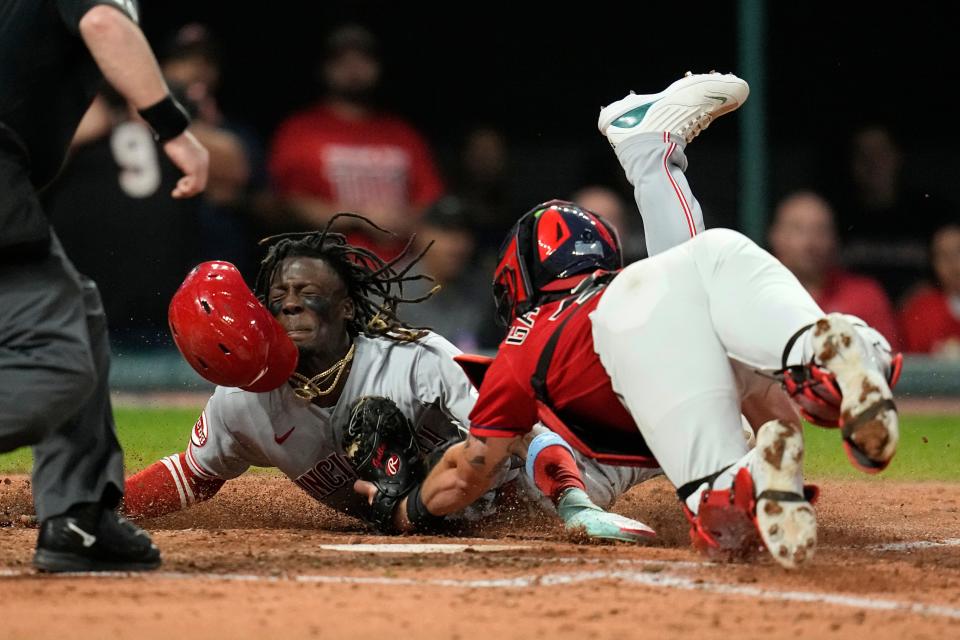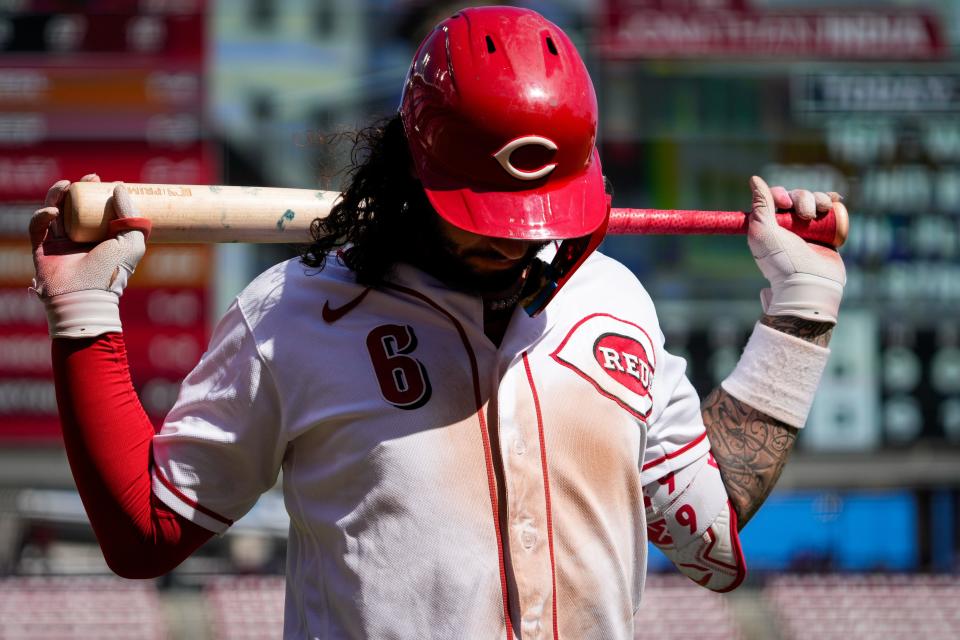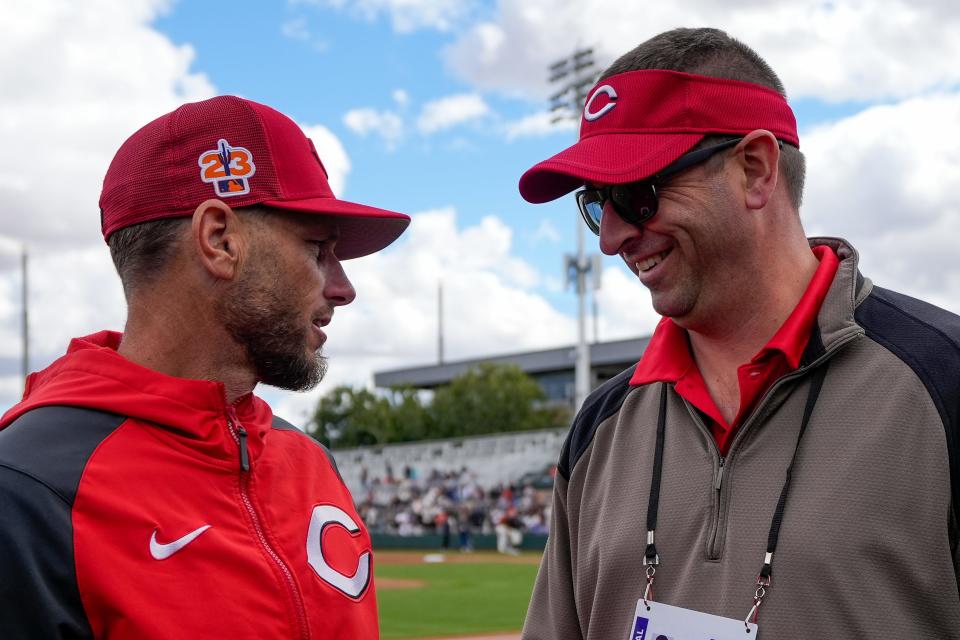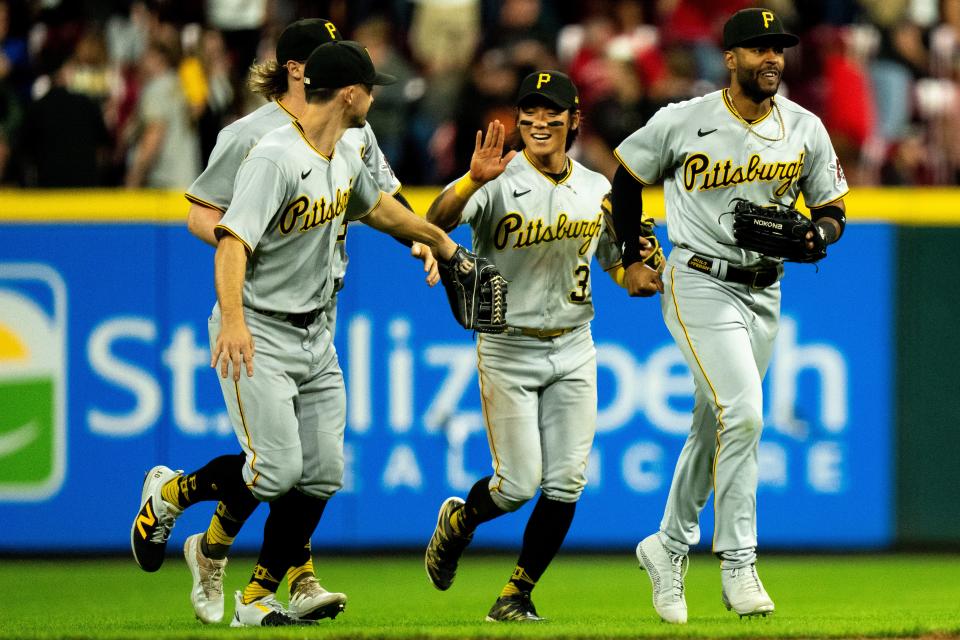Why Nick Krall has no regrets about what went wrong with Reds' wild card chase

ST. LOUIS — When the pixie dust finally settled late Saturday night in St. Louis, and the Cincinnati Reds were officially eliminated from playoff contention the night before their final game, anybody still watching scoreboards might have noticed they got closer to the National League field than it might have seemed at first glance.
With the Arizona Diamondbacks’ loss to Houston, the Reds would have had a shot with a Hunter Greene win and another DBacks loss to the reigning champs to win the final spot on the final day.
As one favorite All-Star from back in the day used to say, “If ‘if’ was a fifth, we’d all be drunk.”
So take it for what it’s worth. Maybe this long-shot, nearly impossible dream for a team that lost 100 games last year never had a realistic chance to finish it off.
But don’t try telling that to anyone in the Reds clubhouse after Saturday’s 15-6 loss to the Cardinals finally ended the ride.

“We just had to win two more. That’s it. We had it,” said an emotional Jonathan India afterward. “We had the team to do it.”
Considering the Reds were in first place in the National League Central as late as first pitch on Aug. 3, it’s hard to say he’s wrong.
Heck, as recently as Sept. 19, they opened the day in a virtual tie with the Cubs for the final playoff spot, a half-game behind Arizona for the No. 2 wild-card position.
“The way this team has played, the way this team has grinded late in games,” newly promoted team president Nick Krall said heading into the final series, “we might have lost games, but we’re still in it. We come back. We fight. We really fight.
“The attitude this group has had is one of my favorites that I’ve ever been around.”
So what went wrong? How did they get so good from mid-May through July, only to struggle so mightily to score and win in August? And then to fade down the stretch in September?
How did they get this close – this/close – only to come up empty?
What went wrong?
At least five specific events and moments proved costliest, and the top two involved the same late-July stretch leading to the Aug. 1 trade deadline:

1. Failure to add a starting pitcher at the deadline despite being in first place with alarm bells sounding all around that area of need. A journeyman, a change-of-scenery guy, a back-end innings eater – even that much pitching added to a beleaguered rotation that struggled all season with injuries and underachievement could have been a godsend for the worst rotation in baseball that isn’t in last place (5.42 ERA behind only Oakland and Colorado). Counting on the injured-list returns of Hunter Greene and Nick Lodolo proved a huge miscalculation, especially when Lodolo suffered a setback with his leg injury and never returned. Greene struggled in multiple starts and also wound up as part of an early-September COVID-19 outbreak.
2. Failure to add more than left-hander Sam Moll to the bullpen at the trade deadline. One lefty was big, and getting Moll from the Oakland Athletics for prospect Joe Boyle (six no-hit innings Saturday against the Angels) proved valuable for a heavily worked bullpen. But they needed at least two. And when the COVID outbreak took down five pitchers in two days, the need became desperate. The Reds simply never had enough depth in their pitching staff as a whole to finish off a playoff season, despite the collective heroic performance of the pen.
Not that Krall would necessarily agree.

The Reds’ top baseball boss was asked before Saturday’s game if any part of him regrets even a little bit not adding more pitching at the deadline, not offering more in prospect/player capital to get a deal done.
“You can look at it as a would-coulda-shoulda, but at the same time,” he said, pausing for a beat, “no. There wasn’t a deal at the deadline that I look back and say we should have made that deal. There’s not a deal there.”
But obviously many pitchers were traded, from the likes of Lance Lynn, Michael Lorenzen and Lucas Giolito to Justin Verlander and Max Scherzer, just among starters.
What about looking back and wishing the Reds had paid the higher price necessary to land the help they so desperately needed. At the end of the day/season, how much would the difference of, say, three wins made?
“There wasn’t something that I was comfortable with moving forward and keeping the group that’s in here together,” said Krall of the big-league roster.
Beyond adding pitching at the deadline, three other controllable events that proved costly:

3. Failing to hold a 9-0 lead against the Pirates in a 13-12 loss at home with six games left to play. They bounced back to win the next two, but that blown lead of historic proportions set the stage for the mad scramble and fingers-crossed sweating over this final week. It’s hard to lose a game after scoring the first nine runs. And it’s the difference between still having a chance on Sunday and being eliminated.
4. Failing to close out games at home Aug. 8-9 against the Miami Marlins and losing both after leading 2-1 in the seventh and 4-1 in the eighth. One of the best teams in baseball at holding late leads would have claimed the tiebreaker against the Marlins with a win in either game and the resulting loss for the Marlins would have kept the Reds in control of their destiny with the Marlins into the final weekend.
5. Nothing. Nothing else. This team had injuries and illness like everybody else, much of it especially ill-timed. But it also bounced back and survived almost everything thrown its way to get to the second-to-last day of the season with playoff hopes intact. The team got better in May, again in June and yet again in July and August with the debuts of key prospects — perhaps most significantly Matt McLain’s and Elly De La Cruz’s promotions dramatically improving the Reds’ previously horrid fielding.
Some might say they had no right to even be in the playoff chase, especially with the starting pitching in the shape it was all year. But here they were. And the talent is real.
And the ride was as spectacular at times as it was sudden and unexpected.
“Just a special team, a special season,” India said.
This article originally appeared on Cincinnati Enquirer: What went wrong for Cincinnati Reds before NL Wild Card chase

